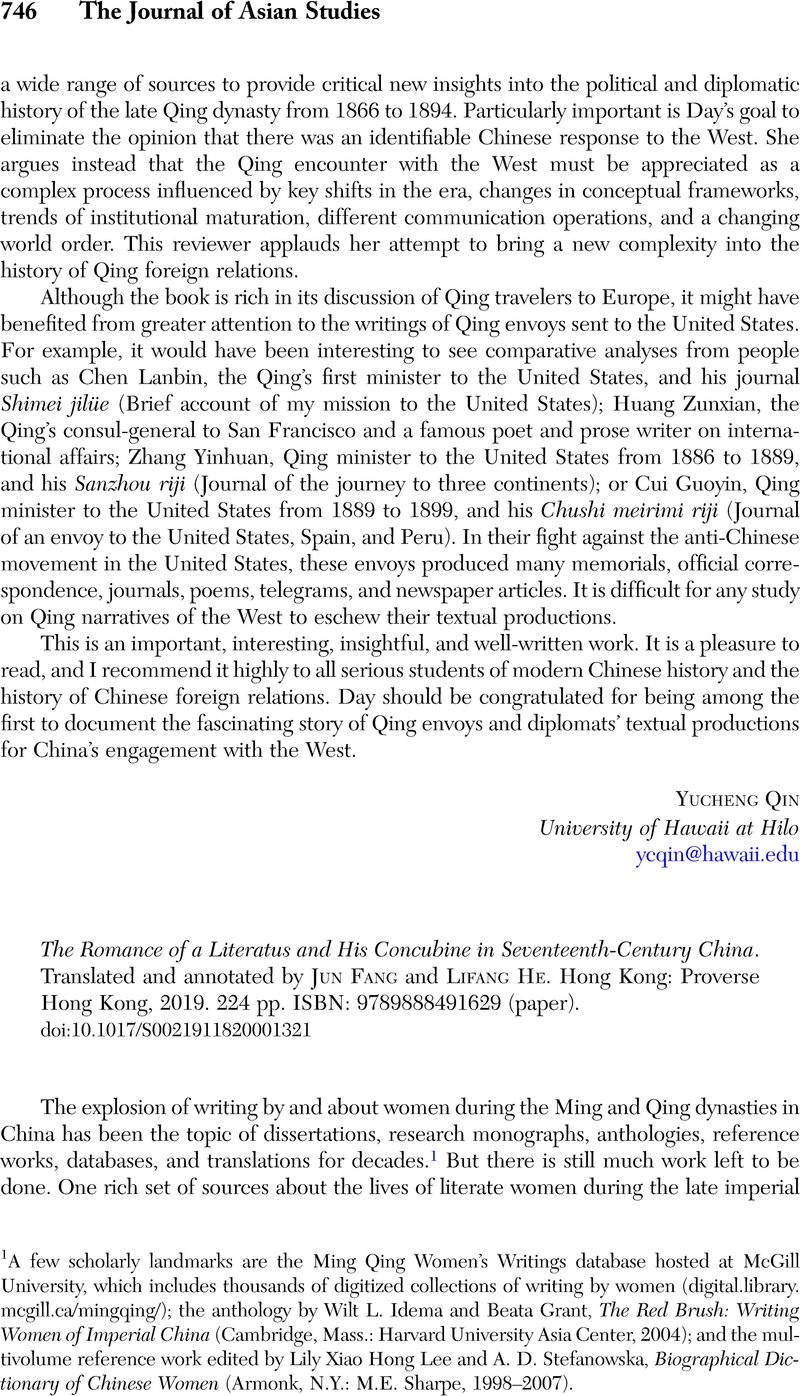No CrossRef data available.
Article contents
The Romance of a Literatus and His Concubine in Seventeenth-Century China. Translated and annotated by Jun Fang and Lifang He. Hong Kong: Proverse Hong Kong, 2019. 224 pp. ISBN: 9789888491629 (paper).
Review products
Published online by Cambridge University Press: 05 October 2020
Abstract

- Type
- Book Reviews—China and Inner Asia
- Information
- Copyright
- Copyright © The Association for Asian Studies, Inc., 2020
References
1 A few scholarly landmarks are the Ming Qing Women's Writings database hosted at McGill University, which includes thousands of digitized collections of writing by women (digital.library.mcgill.ca/mingqing/); the anthology by Idema, Wilt L. and Grant, Beata, The Red Brush: Writing Women of Imperial China (Cambridge, Mass.: Harvard University Asia Center, 2004)CrossRefGoogle Scholar; and the multivolume reference work edited by Lee, Lily Xiao Hong and Stefanowska, A. D., Biographical Dictionary of Chinese Women (Armonk, N.Y.: M.E. Sharpe, 1998–2007)Google Scholar.
2 For an extended discussion of the genre, see Huang, Martin W., Intimate Memory: Gender and Mourning in Late Imperial China (Albany: State University of New York Press, 2018)Google Scholar.
3 Mao repeatedly vacillates in his relationship with Dong, sometimes leaving her in situations of grave physical danger.
4 Mao provides extensive examples of Dong sacrificing her own comforts for the care of her ailing husband (pp. 82–84).
5 Two poems attributed to Dong Xiaowan are preserved in Wanjingyi shihui 晚晴簃詩匯, juan 184, one of which is cited in the introduction by Fang and He (p. 34). Another poem is preserved on a painting of plum blossoms attributed to Dong Xiaowan (pictured in Fang and He, p. 121).
6 According to Fang and He's introduction (p. 34), Mao eventually published Lianyan in three juan in the 1650s. It was well received but fell out of circulation after it was included in a large compendium of women's writings called Ranzhi ji 燃脂集 that was published in 1665. Unfortunately, the bulk of that compendium, including Dong's work, has not survived.
7 Fang and He include a five-chapter version of the original text, which they say (p. 2) they have drawn from a nineteenth-century Daoguang edition of the text, and a twentieth-century edition edited by Mao Guangsheng (1873–1959). They make no mention of the widely circulated version found in Gu Yuan 顧沅 (1799–1851), Ciyantang congshu 賜硯堂叢書 (Changsha: Gushijia, 1830), which is divided into four chapters. (Fang and He seem to have split the third chapter into two separate chapters, but they do not explain their decision to do so.)
8 For the most recent translation, see Shen Fu, Six Records of a Life Adrift, trans. Graham Sanders (Cambridge, Mass.: Hackett, 2011). Some of the language describing intimate domestic life in both memoirs seems to owe a debt to the famous autobiographical essay by the woman poet Li Qingzhao 李清照 (1084–1155), “Jinshilu houxu” 金石錄後序 (Epilogue to records on metal and stone), in which she describes her turbulent life before and after her husband's death during the fall of the Northern Song dynasty.



